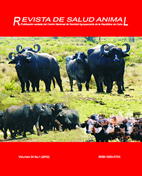MYCOPLASMA DETECTION IN SWINE WITH RESPIRATORY DISEASE IN CUBA
Contenido principal del artículo
Resumen
Dear editor:
In the last years, the Porcine Respiratory Disease Complex (PRDC) has become a serious problem in most of pig producing countries, leading to big economic losses. Mycoplasmas play an important role among the various agents involved in the PRDC. Mycoplasma hyopneumoniae is the etiologic agent of Enzootic Pneumonia and it is considered the most economically significant bacterial respiratory pathogen. However, it has been reported that M. hyopneumoniae may not be the only important mycoplasma pathogen of the respiratory tract of swine. M. hyorhinis and M. hyosynoviae, common inhabitants of the nasal cavity and pharynx of pigs can cause disease in swine. M. flocculare, which is recognized as a non pathogen agent of the lung and nasal cavities of pigs, has been isolated from pneumonic lungs. Other species of questionable pathogenecity, like M. sualvi, M. hyopharyngis and several species of acholeplasmas are found in the respiratory tract of swine and some of them have been reported causing pneumonia, for example, Acholeplasma laidlawii.
The circulation of M. hyopneumoniae and M. hyorhinis associated to respiratory disease in the western and central region of Cuba has been reported. The aim of the present study was to determine the presence of this pathogen agents in the eastern region, and the presence of M. flocculare and other Mollicutes in clinical samples of swine with respiratory disease. A total of 58 clinical samples from 7 provinces including the western, central and eastern region of Cuba was analyzed. The samples, which included 16 nasal exudates, 30 swabs and 12 intrabronchiolar mucus from lungs with typical lesions of enzootic pneumonia, were analyzed by a Mollicutes specific PCR. Positive samples were subsequently analyzed by independent PCR assays for M. hyopneumoniae, M. hyorhinis and M. flocculare detection.
As a result, 39 samples (67%) were positive to Mollicutes infection. From them, the 17% (7 samples) was positive to M. hyopneumoniae , 12% (5 samples) to M. hyorhinis and 10% (4 samples) to M. flocculare. M. hyopneumoniae and M. flocculare were detected co-infecting one sample. In the remaining 24 samples, (61%), none of the previously mentioned species was detected. M. hyopneumoniae was only identified in two provinces of the western region of the country, while M. hyorhinis and M. flocculare were detected in the central and eastern region. Unidentified Mollicutes species were detected in the clinical samples of 6 of the 7 provinces analyzed.
These results prove the circulation of M. hyorhinis in the eastern region of Cuba. Although M. hyopneumoniae was not detected in such region it is advisable to amplify the study in a major number of samples since the number of samples analyzed from this region was very small. Also, a high number of clinical samples infected with Mollicutes species different from the commonly reported pathogens points out the importance of identifying mycoplasma species present in a respiratory disease outbreak, studying their contribution or association with the etiological agents involved in the development of the PRDC.
Detalles del artículo
Aquellos autores/as que tengan publicaciones con esta revista, aceptan los términos siguientes:
- Los autores/as conservarán sus derechos de autor y garantizarán a la revista el derecho de primera publicación de su obra, el cual estará simultáneamente sujeto a la Licencia Creative Commons Attribution-NonCommercial 4.0 International (CC BY-NC 4.0) que prohíbe el uso comercial de sus publicaciones y permite a terceros compartir la obra siempre que se indique su autor y la primera publicación en esta revista. Bajo esta licencia el autor será libre de:
- Compartir — copiar y redistribuir el material en cualquier medio o formato
- Adaptar — remezclar, transformar y crear a partir del material
- El licenciador no puede revocar estas libertades mientras cumpla con los términos de la licencia
Bajo las siguientes condiciones:
- Reconocimiento — Debe reconocer adecuadamente la autoría, proporcionar un enlace a la licencia e indicar si se han realizado cambios. Puede hacerlo de cualquier manera razonable, pero no de una manera que sugiera que tiene el apoyo del licenciador o lo recibe por el uso que hace.
- NoComercial — No puede utilizar el material para una finalidad comercial.
- No hay restricciones adicionales — No puede aplicar términos legales o medidas tecnológicas que legalmente restrinjan realizar aquello que la licencia permite.
- Los autores/as podrán adoptar otros acuerdos de licencia no exclusiva de distribución de la versión de la obra publicada (p. ej.: depositarla en un archivo telemático institucional o publicarla en un volumen monográfico) siempre que se indique la publicación inicial en esta revista.
- Se permite y recomienda a los autores/as difundir su obra a través de Internet (p. ej.: en archivos telemáticos institucionales o en su página web) antes y durante el proceso de envío, lo cual puede producir intercambios interesantes y aumentar las citas de la obra publicada. (Véase El efecto del acceso abierto).
